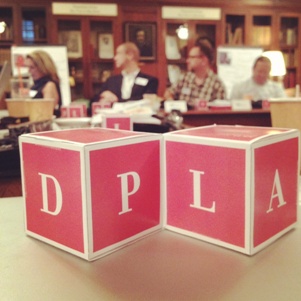This is the fourth in an occasional series of articles that will explore issues surrounding the efforts to launch and expand the Digital Public Library of America (DPLA).
 Publishers, ebook vendors, and libraries are engaged in a “tug-of-war” over the lending of electronic books, according to Library Journal’s recent ebook survey. This clash inhibits most libraries from fulfilling their important institutional missions to provide access to knowledge and preserve our cultural heritage. In the best case, this tug of war will be a temporary struggle. The best outcome is not a winner who holds all the rope and another lying on the ground with rope-burned hands. If there must be a winner of any kind, it ought to be the reading public.
Publishers, ebook vendors, and libraries are engaged in a “tug-of-war” over the lending of electronic books, according to Library Journal’s recent ebook survey. This clash inhibits most libraries from fulfilling their important institutional missions to provide access to knowledge and preserve our cultural heritage. In the best case, this tug of war will be a temporary struggle. The best outcome is not a winner who holds all the rope and another lying on the ground with rope-burned hands. If there must be a winner of any kind, it ought to be the reading public.
In this article, the fourth installment in a series on the initiative to build a Digital Public Library of America, I examine the underlying role of law in the ebook lending debate, explore potential solutions to the problems, and consider how the DPLA can contribute to solutions for those we serve. At the core of this issue is the way the copyright law works—or doesn’t—when it comes to books, libraries, and readers in the United States today and into the future.
A bit of background on the relevant law helps to set the scene for the tug-of-war. In the United States, copyright law grants to the creators of original works of authorship a bundle of exclusive rights—namely, the ability to exclude legally others from copying, adapting, distributing, displaying, and performing their creations. Should an individual (or a library, for that matter) make use of a copyrighted work in a manner that implicates one of these rights, an exception to the law must apply; otherwise, the copyright owner may be able to make a successful claim for infringement.
Before ereaders and ebooks began their recent rise to popularity, libraries could acquire, lend, and preserve most in-copyright printed materials with relative ease—as long as they had the budget and space in their stacks. For instance, libraries could easily add print materials into their collections that came in as donations (though, as any acquisitions librarian knows, donations are most often a mixed bag). Libraries can also make a limited number of digital copies of printed texts for purposes of noncommercial lending and archiving, which helps to ensure books that are badly damaged or no longer sold commercially are not lost to the public. Limitations in the Copyright Act enable these acts by libraries. Some of the elements of the law are omnibus in nature—meaning they apply to everyone—and some of these provisions apply specifically to libraries.
First Sale
One of the limitations within copyright law that makes book lending (and secondhand book sales) easy in the analog era is called the “first sale doctrine.” Established in a landmark Supreme Court case in 1908 and formally codified in the Copyright Act in 1909, the first sale doctrine limits the copyright holder’s right to distribution in a way that applies to everyone, not just libraries. The first sale doctrine states that the owner of a copy of a copyrighted work “is entitled, without the authority of the copyright owner, to sell or otherwise dispose of the possession of that copy.” In plain English: copyright law only affords to the creator control of the first sale or distribution of a material copy of a work. Once a copy has been sold, the copyright owner can no longer stop that copy from being resold, lent, rented, or otherwise transferred to others. (Other rights still attach; for instance, the new owner of the book does not have the right to make a movie based on the book, which would violate another of the exclusive rights still held by the copyright holder.)
 The first sale doctrine is the cornerstone that made possible secondary markets for copyrighted materials at video rental stores, used book and music stores, and libraries. In conjunction with other limitations in the Copyright Act, including fair use and other library-specific exceptions, first sale enables libraries to build collections through donations, lend works to patrons, participate in interlibrary loan arrangements, and archive and preserve works for the benefit of future generations—all at minimal cost and without requiring authorization from copyright owners. As the American Library Association (ALA) website puts it, “Quite simply, first sale is what allows libraries to do what we do—lend books and materials to our patrons, the public.”
The first sale doctrine is the cornerstone that made possible secondary markets for copyrighted materials at video rental stores, used book and music stores, and libraries. In conjunction with other limitations in the Copyright Act, including fair use and other library-specific exceptions, first sale enables libraries to build collections through donations, lend works to patrons, participate in interlibrary loan arrangements, and archive and preserve works for the benefit of future generations—all at minimal cost and without requiring authorization from copyright owners. As the American Library Association (ALA) website puts it, “Quite simply, first sale is what allows libraries to do what we do—lend books and materials to our patrons, the public.”
The introduction of digital materials, particularly ebooks, has made things much more complex when it comes to libraries and lending. As we have seen in other content industries, the shift from print to digital has disrupted the publishing industry, forcing publishers to adapt to a host of new media quickly. This transition is no small feat, considering that this is an industry that has relied on the same basic models for centuries. The shift has highlighted the limitations of the Copyright Act in U.S. law, which was designed to apply in a world in which knowledge was recorded and then “fixed” (a key term in the copyright statute) in tangible, physical media. Much to the consternation of libraries and those they serve, these changes have caused publishers to rethink business and legal structures regarding how, if at all, they make available works for library lending.
Digital Difference
Print works are conventionally sold or donated to libraries. Invoking the first sale doctrine and other provisions under the law, libraries could lend their legally purchased print copies to patrons, to other libraries, and to the patrons of other libraries (think of the extremely effective interlibrary loan systems that link libraries, and their patrons, to one another). Digital works, in contrast, are typically licensed, not sold, to libraries and consumers. Licenses take the form of enforceable contracts, in which permissions are granted to do or use something that otherwise would be the exclusive right of a property owner. The licenses offered by publishers to readers (or libraries) often contain additional terms and conditions that govern the scope and nature of the permission being granted. Should the terms be violated, the licensee might not only lose the legal right to possess the work, but also the licensor can seek recourse in court for a breach of contract. These licenses add restrictions on what can be done with the works that do not exist under copyright law. This is not a new problem; those who worry about copyrights have been arguing over this issue for 30 years, in the context of software and other forms of intellectual property. Libraries are the most recent case of acquirers who are becoming renters, not owners, of digital materials.
For libraries, the distinction between a license and a sale—the difference between renting and owning a copy—is critical. In the case of a digital book, the copyright holder maintains a stricter form of “ownership” of a licensed copy—and much more control over what can be done with it—than in the case of an old-fashioned, analog book. Put another way, there has been no transposition of the first sale doctrine into the digital sphere. As a result, the first sale doctrine does not apply to licensed copies. By definition, a digital book or sound recording or image is not owned by the licensee. Libraries do not own their copies of ebooks, at least not in the same sense they own their copies of printed books. The ability of libraries to provide their patrons with access to an ebook is conditional upon their ability to adhere to the license terms.
Libraries are consistently encountering license terms that prohibit or restrict their ability to provide core services to patrons. These restrictions mean that libraries worry that they cannot make copies of works for archival and format preservation purposes. Librarians worry that they cannot participate in interlibrary loan programs using digital works, or even print pages under some licenses. Some ebook licenses expire after an ebook reaches a specified number of circulations, requiring the library to repurchase a costly license—plainly a less perfect arrangement for a library than being able to buy a copy of a book outright. Where the license terms leave off, file formats can pick up with technological protections that govern—in the technical sense—how a work may be accessed and used through software and hardware. Although it is technically possible to overcome these technological measures (known as digital rights management), amendments to the Copyright Act in 1998 make unlawful the circumvention of such technological controls.
emerging Concerns
At the same time, patron demand for ebooks is surging. The trend in favor of ebook reading is clear. Although the percentage of major publishers that offer lendable ebooks shows signs of improvement from a library patron’s perspective, many publishers have simply refused to participate in lending programs or will only do so under a restrictive license. Libraries have had limited success in negotiating terms in their favor. License terms can supersede exceptions in the Copyright Act, including the very limitations upon which libraries so heavily rely, and impose restrictions on the manner in which works may be accessed and used by patrons. The net effect is that a license allows for substantial control, particularly in cases where the licensee has little or no negotiation power.
These problems might be the product of temporary market growing pains. Many uncertainties remain for the growing volume of born-digital materials. Some libraries, especially children’s and school libraries, rely heavily on donations of books that are made possible by the first sale doctrine. However, a licensed ebook is unlikely to be shareable with another library for lending purposes under current license terms. How will these libraries grow their digital collections? Even works in the public domain, whose copyright terms have expired or where no copyright attached in the first place, may end up being produced as ebooks under onerous licenses or technical protection measures. If libraries are prohibited from preserving and archiving ebooks, in-copyright works may become orphans—works whose copyright owners become lost amid poor record keeping, consolidation in the publishing industry, and bankruptcy.
 Librarians and legal scholars have called upon the courts and Congress for legislative reforms to rebalance the law to protect the interests of library users. For example, the Copyright Act could be amended simply to create a broad and effective “digital first sale” doctrine. In a more narrowly tailored fashion, Congress could provide libraries with special rights to ensure they can lend, archive, and preserve ebooks. More expansively, Congress could implement a compulsory license system, whereby libraries and publishers agree to royalty fees for ebooks, which must be provided for digital lending through libraries. The legal system today might allow for readers and libraries to challenge the legality of particularly harmful licensing practices, like the contractual restrictions on fair use and the special exceptions granted to libraries; however, challenges of this sort can be long, expensive, and often inconclusive. The judiciary may take matters into its own hands, too. It is also possible that one pending case in particular—Capitol Records v. ReDigi—could prove to have a transformative effect on how the first sale rule is interpreted by future courts in the digital environment.
Librarians and legal scholars have called upon the courts and Congress for legislative reforms to rebalance the law to protect the interests of library users. For example, the Copyright Act could be amended simply to create a broad and effective “digital first sale” doctrine. In a more narrowly tailored fashion, Congress could provide libraries with special rights to ensure they can lend, archive, and preserve ebooks. More expansively, Congress could implement a compulsory license system, whereby libraries and publishers agree to royalty fees for ebooks, which must be provided for digital lending through libraries. The legal system today might allow for readers and libraries to challenge the legality of particularly harmful licensing practices, like the contractual restrictions on fair use and the special exceptions granted to libraries; however, challenges of this sort can be long, expensive, and often inconclusive. The judiciary may take matters into its own hands, too. It is also possible that one pending case in particular—Capitol Records v. ReDigi—could prove to have a transformative effect on how the first sale rule is interpreted by future courts in the digital environment.
New Models
Beyond the legal options, there is also an opportunity for the creation of new business models that would satisfy both publishers and libraries. In July 2012, we at Harvard’s Berkman Center published a report to help others understand the variables associated with library ebook lending and to inspire the creation of new business models. ALA’s Digital Content and Libraries Working Group has also contributed important scholarship to this area. Libraries, publishers, authors, and their agents might make common cause in the form of a series of experiments in ebook lending that could lead to a market-oriented solution.
 The DPLA does not offer a simple answer to this complex problem. When the DPLA launches in April 2013, the initial emphasis falls on establishing a shared platform for libraries and works that are in the public domain, not solving the ebook lending problem.
The DPLA does not offer a simple answer to this complex problem. When the DPLA launches in April 2013, the initial emphasis falls on establishing a shared platform for libraries and works that are in the public domain, not solving the ebook lending problem.
At a minimum, the DPLA community will continue to advocate on behalf of libraries and their readers. DPLA partners, led by Berkeley’s Pam Samuelson and Columbia’s Jim Neal, have been exploring innovative legal approaches to the problems facing libraries in a digital age through the Legal Issues work stream. The Berkeley Digital Library Copyright Project has produced a series of path-breaking white papers that explore solutions to these issues and submitted them to the Copyright Office for consideration. The DPLA team will tirelessly work toward identifying feasible solutions that remove the barriers to e-lending.
As a next step, the DPLA is working with local libraries and content partners to digitize and provide access to public domain works. By starting here, the DPLA can ensure that access to these digital materials is preserved without license restrictions. The DPLA community will also continue to investigate options for alternative lending models, including the lending of digitized print books championed by Brewster Kahle (and, in a previous role, Peter Brantley). Kahle, Brantley, and their colleagues argue that we need nothing more than the existing library rights in the Copyright Act to get done much of what we need for readers, and they’ve set out to prove it through their Open Library initiative.
The DPLA might do more to address the problem of ebook lending over time. The DPLA is, at its core, an effort to solve the collective action problem facing libraries in a digital age. A successful DPLA movement could create openings to help address the issue of digital lending through development of a platform for collaborative work in the public interest. By working together on a public option, libraries can establish a public beachhead in the digital space today dominated by for-profits, including Amazon, Google, OverDrive, and commercial publishers. Those of us who care about libraries need to link arms in order to push back on trends in the law and technology that favor restrictions on access, rather than increased access, in a digital age. Libraries can and should become more actively engaged in building the digital commons, through open source code, open access approaches to publishing, and innovative means of making in-copyright digital material available to readers.



If there must be a winner of any kind, it should be the reading public? No. If there must be a winner, it should be those who invest in creating new materials. Without that, there is nothing for the reading public to read.
Why would those who invest in creating new materials loose something if the first sale doctrine is to be applicable to digital material? In “first sale”, there is the word sale. They already sold something (they say license, but in fact this is more a sale than a license). Even if the copy is digital, this is still a copy. By applying the first sale doctrine to digital copies, those who create new materials don’t lose anything. But by not applying the first sale doctrine, humanity loose the right to preserve precious material.
Thank you for the enlightening article. I had no idea how important the first sale doctrine is to libraries!